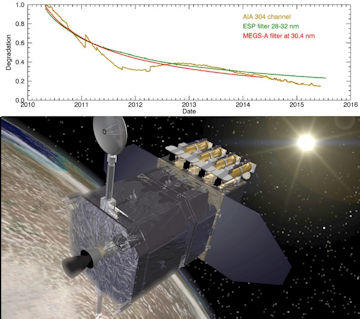Summary
Optical systems that operate at wavelengths in the ultraviolet (UV) and extreme-ultraviolet (EUV) are susceptible to degradation by a number of different processes that depend on the photon energy, the optic material and the local environment. With a peak output near 7 nm, the Synchrotron Ultraviolet Radiation Facility (SURF III) is well suited to study degradation processes impacting the extreme ultraviolet lithography (EUVL) industry, which operates at 13.5 nm, and the many scientific and commercial endeavors that rely on satellite measurements of the sun in the EUV and UV.
Description

The primary degradation process in EUVL tools and satellite instruments begins by the adsorption of water or carbonaceous molecules from the vacuum environment onto the optic surface. The optic is damaged if the molecule undergoes photon-stimulated decomposition before it can (reversibly) thermally desorb. Dissociation of adsorbed water can lead to oxidation of the surface, and decomposition of carbon-containing species can (irreversibly) deposit carbon on the surface.
Despite their vastly different operational environments and technical goals, the satellite and lithography communities share several common concerns regarding optics degradation:
- Sensitivity to small degradation rates
- A loss of 2 % on only a few optics in an EUVL system can push the yield below the threshold of economic viability.
- A 2 % per month degradation can reduce the useful lifetime of a satellite instrument from decades to a few years.
- Practical inaccessibility
- It is not economically feasible to regularly service the optics in high-volume EUVL systems due to the substantial costs of system downtime and re-alignment.
- Optics in space cannot be serviced at all.
- Limited control over the environment
- Lithographic systems cannot be baked to reduce outgassing due to the nanometer-level alignment requirements and the thermal sensitivity of the optics themselves, and the outgassing induced by irradiation of the resist-coated wafers is a constant source of contamination.
- The environment in space can be difficult to predict or control.
- Required high performance over long lifetime
- To maintain profitable operation EUVL optics cannot degrade by more than ~2 % over the entire 5 year operational life of the tool.
- Satellite instruments are expected to provide a record of accurate, consistent measurements over decades.
NIST has been a leading centers in the study of EUVL optics contamination from the very beginning around 2000, and we have recently begun investigating the degradation of filters commonly used in satellites. We currently have three facilities on two beamlines devoted to various aspects of optics contamination.
Beamline 8 was originally designed to measure the degradation processes of samples exposed to 13.5 nm radiation in the presence of admitted gases that are expected to have low to moderate contamination rates and are unlikely to permanently contaminate the vacuum system. It can also be easily modified to study degradation at the longer wavelengths relevant to solar-observing satellite instruments.
Beamline 1a is similar to beamline 8, but it is designed to study species with high contamination rates.
Beamline 1b with its large EUV power, was the first publicly accessible facility in the world capable of measuring to industry standards the contamination potential of photoresists outgassing. First-generation EUVL tools could be operated using only resists that had been qualified by such measurements. Beamline 1b served as the benchmark for other commercial systems around the world that were subsequently built to meet the demands of then ascent EUVL industry.
Major Accomplishments
| NIST Result | Impact |
|---|---|
| Developed techniques for measuring contamination rates at partial pressures below 10-7 Pa | Enabled accurate assessment of contamination risk in EUVL tools |
Demonstrated two regimes of scaling laws for carbon contamination rates
|
Provide data to inform EUVL tool design and operation
|
| Showed that contamination rates at wavelengths in the range (60 to 70) nm can be 10 times greater than rates at 13.5 nm | Provide data to inform EUVL tool design
|
| Discovered that the original industry-established protocol for measuring the outgas contamination potential of resists could depend strongly on temperature | Worked with other testing labs to improve reliability of outgas testing protocols |
| Discovered that the original industry-established protocol for measuring the outgas contamination potential of resists could depend strongly on temperature | Worked with other testing labs to improve reliability of outgas testing protocols |
| Performed measurements that strongly indicate oxidation as the primary degradation mechanism of filter materials used in solar-observing satellites. (The solar-observing community has long attributed the degradation to carbon deposition.) | Improved accuracy and reduced costs of current and future satellite instruments
|

